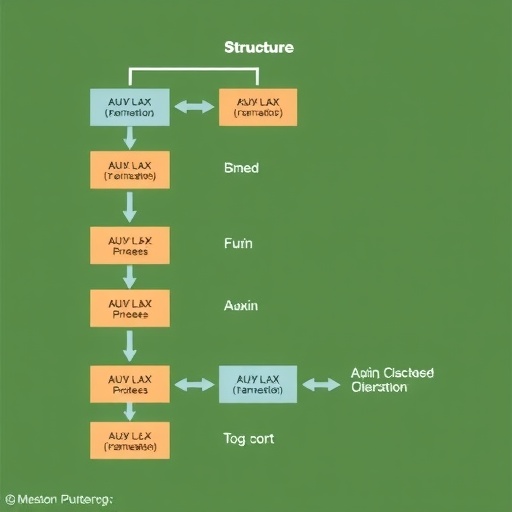In the intricate world of plant biology, the hormone auxin stands as a pivotal regulator of growth, development, and environmental response. Despite its central role, the molecular underpinnings governing auxin uptake into plant cells have remained elusive for decades. A groundbreaking study published in Nature Plants in 2025 by Ung, Schulz, Zuzic, and colleagues heralds a new era of understanding, offering unprecedented insight into the structure and mechanism of AUX/LAX transporters, the long-suspected gatekeepers of auxin import. This revelation not only advances fundamental botanical science but also opens avenues for agricultural innovation and synthetic biology applications.
At the core of plant development, auxin orchestrates various physiological processes such as cell elongation, tissue patterning, and adaptive responses to environmental cues. It achieves these feats by modulating gene expression and cellular behaviors in a tightly regulated manner. However, auxin is a charged molecule at physiological pH, rendering its passive diffusion across the hydrophobic lipid bilayers of the plasma membrane highly inefficient. This limitation pointed researchers toward specialized carriers facilitating auxin transport—a hypothesis validated through years of genetic and biochemical studies implicating the AUX/LAX family as essential auxin influx facilitators.
Despite their recognized importance, the precise molecular architecture and transport modality of AUX/LAX proteins have been largely speculative due to the intrinsic challenges in resolving membrane protein structures. The team led by Ung et al. surmounted these barriers by employing cutting-edge cryo-electron microscopy (cryo-EM) combined with functional assays, culminating in high-resolution structural models of these transporters. These models illuminate the conformational dynamics and substrate interactions that underpin auxin recognition and translocation across the cell membrane.
The revealed structures demonstrate that AUX/LAX transporters share a canonical fold characteristic of the Amino acid-Polyamine-Organocation (APC) transporter superfamily, embodying a sophisticated mechanism of ligand binding coupled to alternating access conformational changes. This alternating access model posits that the transporter cycles between inward-facing and outward-facing states, enabling directional auxin movement driven by electrochemical gradients. Intriguingly, Snapshots along the transport cycle captured through structural analyses detail the transition states, highlighting key residues involved in auxin affinity and specificity.
Mechanistic dissection unveiled that AUX/LAX proteins operate via symport, coupling auxin import with protons (H+), exploiting the proton motive force characteristic of plant cell membranes. This proton-coupled transport is critical for maintaining directional auxin influx and cellular homeostasis. The study meticulously maps out the H+ binding sites and reveals how protonation events trigger conformational shifts facilitating substrate translocation. The elucidation of this proton-coupled mechanism refines previous models and reconciles biochemical data accumulated over the last several decades.
From an evolutionary perspective, comparative structural and sequence analyses disclosed that the AUX/LAX family has diverged in angiosperms to finely tune auxin uptake efficiency and regulation. The study identifies conserved motifs indispensable for function across species alongside variable regions potentially linked to differential regulation or tissue-specific expression patterns. This evolutionary insight bolsters the functional relevance of the transporter family and their role in adapting plant growth strategies to diverse ecological niches.
Functional assays incorporating site-directed mutagenesis further corroborate the structural findings. Mutation of several residues lining the auxin binding pocket or proton translocation pathway results in marked transport impairment, validating the predicted mechanistic roles. Additionally, heterologous expression in yeast and plant protoplasts coupled with auxin uptake measurements quantitatively demonstrate the impact of these mutations on transport kinetics, underscoring their physiological significance.
The authors also explore the dynamic interplay between AUX/LAX transporters and other auxin transport systems, particularly the PIN-FORMED (PIN) efflux carriers. The coordinated activity of influx and efflux carriers establishes directional auxin fluxes essential for morphogenesis and environmental responses. Insights into the structural basis of AUX/LAX function enrich models of auxin distribution in planta and suggest potential avenues to modulate transport activity via targeted genetic or chemical interventions.
Beyond fundamental biology, this work carries profound implications for agriculture and biotechnology. Modulating AUX/LAX transporter activity could enable the engineering of crops with optimized growth patterns, improved stress resilience, or altered architecture to enhance yield. Additionally, the structural blueprint offers a platform for rational design of small molecules capable of fine-tuning auxin transport, presenting novel agrochemical strategies for crop management.
The research exemplifies the power of integrative structural biology in deciphering complex biological systems. Leveraging advances in cryo-EM technology to resolve plant membrane transporters at near-atomic resolution represents a significant technical triumph, setting the stage for comprehensive studies of other elusive plant transporter families. It also illustrates the synergy achieved by integrating structural, biochemical, and functional methodologies, enabling multifaceted insights that transcend the limitations of individual approaches.
Looking forward, the study opens several exciting research directions. Unraveling how AUX/LAX transporters are regulated post-translationally, how they interact with cellular signaling networks, and how their expression is modulated during development or stress responses will be crucial next steps. Moreover, structural snapshots of transporter complexes with auxiliary proteins or regulators could shed light on the higher-order regulatory machinery controlling auxin import.
In conclusion, the structural elucidation of AUX/LAX transporters by Ung and colleagues constitutes a landmark achievement in plant biology. It demystifies the molecular gymnastics underpinning auxin import, a cornerstone process steering plant growth and adaptation. This work not only enriches our understanding of plant physiology but also ushers in new possibilities for harnessing auxin transport mechanisms to engineer future crops and address pressing agricultural challenges amid global environmental change.
Subject of Research: AUX/LAX transporters involved in auxin import in plants
Article Title: Structures and mechanism of the AUX/LAX transporters involved in auxin import
Article References:
Ung, K.L., Schulz, L., Zuzic, L. et al. Structures and mechanism of the AUX/LAX transporters involved in auxin import. Nat. Plants (2025). https://doi.org/10.1038/s41477-025-02056-z
Image Credits: AI Generated




